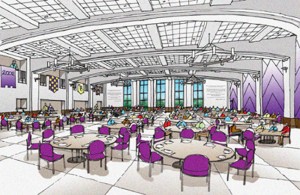Creating The School of the Future
Originally published in Midwest Real Estate News September 1, 2003
By Michael McNeil
 What started as a vision less than 24 months ago in St. Louis has grabbed the attention of educators, school administrators and technology directors across the country. A construction company, an architect and a technology partner joined forces with Christian Brothers College High School (CBC) and together created the $45 million “school of the future”.
What started as a vision less than 24 months ago in St. Louis has grabbed the attention of educators, school administrators and technology directors across the country. A construction company, an architect and a technology partner joined forces with Christian Brothers College High School (CBC) and together created the $45 million “school of the future”.
Sonacom was hired to consult, design and install and work side-by-side to implement the school’s vision: to provide an infrastructure that will allow CBC to consistently stay on the cutting edge of new technology. There were no schools to pattern it after, no similar complete educational technology platforms being used—not on the East Coast, not on the West Coast, not in public education or in private schools. To the knowledge of Sonacom and CBC, it simply didn’t exist. While Sonacom had years of educational experience, both for public school districts and for the private sector, this was different. While many new projects or renovations address information technology as an afterthought, after the walls are up, technology was the starting point for this project.
When the new 224,000 square foot campus at 1850 De LaSalle Drive in Town & Country, Missouri opens for the fall semester on September 2, it will feature a traditional curriculum in a wireless environment. CBC, an all-boys school serving about 1,000 students, has a 152-year tradition of providing quality Catholic education in St. Louis. The school has leaders who want to maximize technology for collaborative learning, so they made sure technology was an integral part of the new school’s design and construction.
At first glance, the all brick building has a very traditional appearance. Turrets, reminiscent of the old school, still grace the entrance and stained glass windows and religious statues from the previous facility have places of importance on the new campus. The library surrounds the chapel, amplifying the school’s commitment to a faith-based education. Guidance offices overlook the dining hall, lockers grace the hallways, and the new gymnasium boasts a solid wood floor. While there are no chalkboards in the classrooms, there are still whiteboards and the rooms have the feel of classrooms of the past. Small closets in the corner of each room store the technology tools that make the school unique.
 Students will take notes using personal laptops (IBM Think Pads, R40, with Intel Centrino processors), while teachers will use electronic whiteboards to display their notes or switch students’ laptops on-screen. Data can also be transferred to the students’ laptops. Video projectors in the classrooms will be hooked into the electronic whiteboards and teaching stations, which feature internet connectivity. Ultimately, students will use swipe cards instead of cash in the cafeteria, snack bar and bookstore. Technology will be evident in every are of the school, including 52 classrooms, 11 specialty classrooms (art, fine arts, labs, computer instruction areas, television studio), the 3,000-seat stadium, 385-seat performing arts center, 300-seat chapel, 500-seat dining area and 1,800-seat gymnasium.
Students will take notes using personal laptops (IBM Think Pads, R40, with Intel Centrino processors), while teachers will use electronic whiteboards to display their notes or switch students’ laptops on-screen. Data can also be transferred to the students’ laptops. Video projectors in the classrooms will be hooked into the electronic whiteboards and teaching stations, which feature internet connectivity. Ultimately, students will use swipe cards instead of cash in the cafeteria, snack bar and bookstore. Technology will be evident in every are of the school, including 52 classrooms, 11 specialty classrooms (art, fine arts, labs, computer instruction areas, television studio), the 3,000-seat stadium, 385-seat performing arts center, 300-seat chapel, 500-seat dining area and 1,800-seat gymnasium.
The “school of the future” started with a vision and that vision was put to the test in a 25-foot by 30-foot demonstration room on the former campus—a room that could hold the key for the future technology in education. The construction team for the new school came together and gutted an existing classroom to make way for the demo room to test available technologies, hardware and software. Its advantages quickly became apparent.
First and foremost, the room became the training ground to allow students, faculty and administrators to become familiar with the wireless environment and systems they will be using in the new school. When the fall semester begins, the building will be new but the educational tools familiar. Teachers will be able to hit the ground running and students will already be trained, so the learning can begin day one. A freshman technology boot camp is also scheduled. The demo room gave CBC and Sonacom the opportunity to test monitors versus projectors, button control panels versus touch screens and different types of electronic white boards, laptops, batteries, and software in an actual classroom setting instead of on a showroom floor. Sonacom and CBC selected and configured the best technology available today and made it workable and expandable. While the technology at CBC is advanced, it primarily consists of off-the-shelf, proven hardware and software.
However, one piece to solve in this multifaceted puzzle was keeping the laptops charged all day, so Sonacom found a Canadian firm that designs a thin, rectangular batter that fits under the laptop’s base. There, of course, will be a laptop “hospital” for those that encounter a technical difficulty or forget to charge their battery at home. The new battery is slated to hold a 21-hour charge—approximately enough charge for three full school days.
Beyond a valuable testing ground for equipment, the $50,000 demo room has saved CBC time and money. Estimates in cost savings exceed several hundred thousand dollars. CBC was able to wrap building features around technology instead of the other way around. The demo room has provided firsthand knowledge on more than just specific technical issues. The contractor (Alberici Constructors) and architect (Mackey Mitchell Assoc.) also benefited from the demo room—lights, blinds, desks, teaching stations, chairs and podiums all changed from initial concepts because the students and faculty were able to try them out. So when CBC opens, there won’t be near the surprises and challenges typically associated with a new building. The room became so valuable that a demo room is also being set up for the new building that will allow CBC to continue to test equipment, integrate new technologies and determine what works best in the new environment.
Technology tools morph daily. No one dreamt that PC’S would go into places like lecterns, that laptops would revolutionize the ergonomic industry, and that new telephones would become Web browsers—or that a private Midwestern boys school would set the standard in educational technology. The team designed the new CBC campus to be a first-class institution, flexible enough to last another 100 years—from the architecture to the technology and everything in between.
Michael McNeil is president of St. Louis-based Sonacom.
No comments yet.